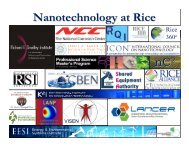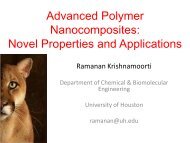Richard E. Smalley Institute for Nanoscale Science and - Center for ...
Richard E. Smalley Institute for Nanoscale Science and - Center for ...
Richard E. Smalley Institute for Nanoscale Science and - Center for ...
Create successful ePaper yourself
Turn your PDF publications into a flip-book with our unique Google optimized e-Paper software.
Pulickel Ajayan<br />
James Tour<br />
Boris Yakobson<br />
34<br />
The Grid • Armchair Quantum Wire<br />
Transport energy as electricity over wires<br />
rather than as mass (coal, oil, gas)<br />
(see Page 26)<br />
Energy Storage<br />
Fuel Cells, Batteries, Hydrogen Storage<br />
Professor Pulickel Ajayan investigates<br />
nanomaterials <strong>for</strong> energy generation <strong>and</strong><br />
storage. Ajayan’s research group is particularly<br />
interested in carbon nanotube<br />
<strong>and</strong> nanocomposites in supercapacitors,<br />
batteries <strong>and</strong> their hybrids. Of particular<br />
note, coaxial carbon-nanotube/metal-oxide<br />
arrays were synthesized as an electrode<br />
material to enhance lithium-ion battery<br />
lifetime <strong>and</strong> capacity. Additionally, this<br />
technology could prove beneficial <strong>for</strong> supercapacitors<br />
<strong>and</strong> fuel cells.<br />
Professor Tour’s laboratory is exploring<br />
carbon nanostructures <strong>for</strong> hydrogen storage.<br />
One nanostructure being investigated<br />
is a cross-linked carbon nanotube fiber.<br />
Because of the fiber’s density, it adsorbs<br />
twice as much hydrogen than typical<br />
macroporous carbon materials per unit of<br />
surface area.<br />
Professor Boris Yakobson’s computational<br />
research recently detailed why graphene<br />
may be a viable carrier <strong>for</strong> hydrogen-based<br />
energy systems of the future, as small<br />
variations in temperature <strong>and</strong> pressure<br />
can effectively control the capture <strong>and</strong><br />
release of hydrogen atoms. Graphene is<br />
the individual layers that make up graphite<br />
— pencil lead.






